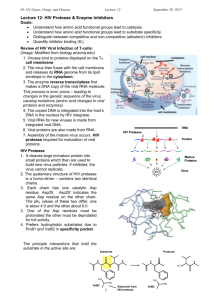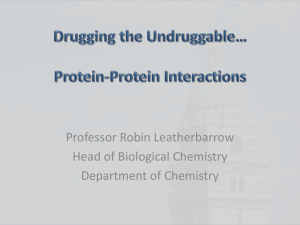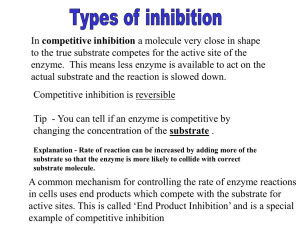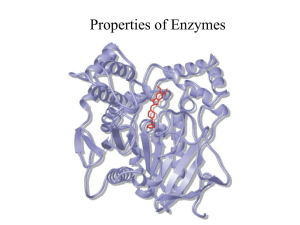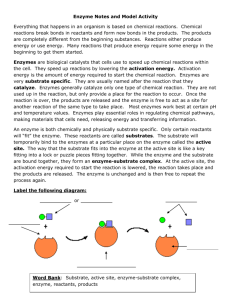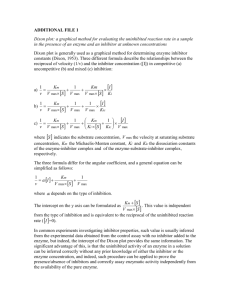Lecture 5 - Andrew.cmu.edu
advertisement
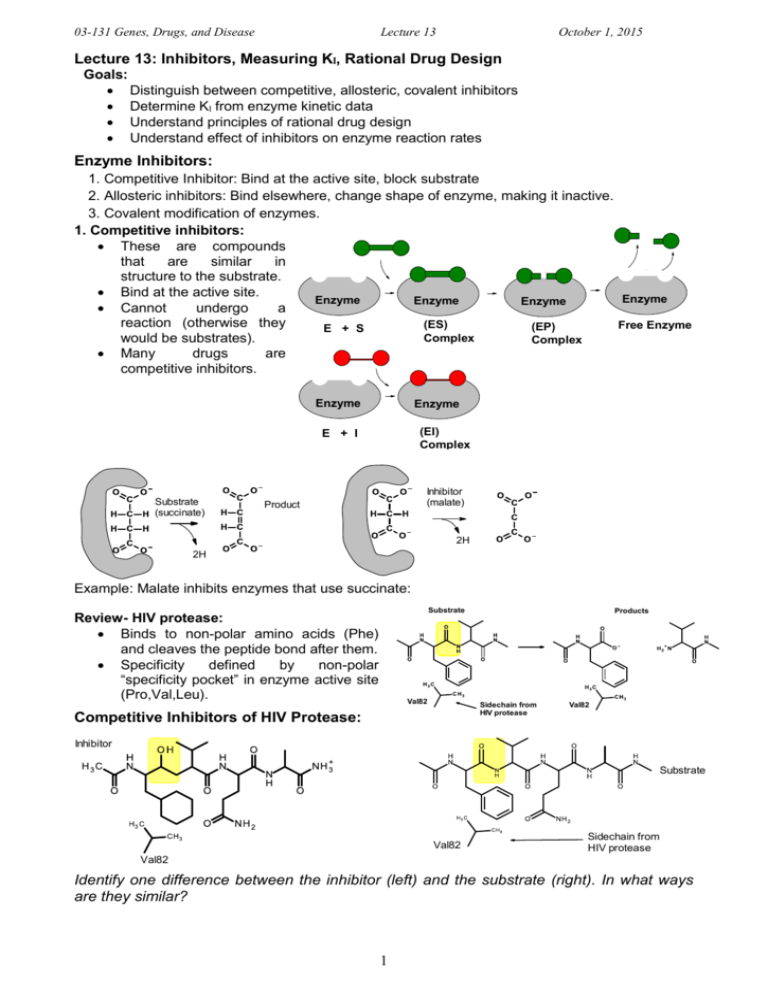
03-131 Genes, Drugs, and Disease Lecture 13 October 1, 2015 Lecture 13: Inhibitors, Measuring KI, Rational Drug Design Goals: Distinguish between competitive, allosteric, covalent inhibitors Determine KI from enzyme kinetic data Understand principles of rational drug design Understand effect of inhibitors on enzyme reaction rates Enzyme Inhibitors: 1. Competitive Inhibitor: Bind at the active site, block substrate 2. Allosteric inhibitors: Bind elsewhere, change shape of enzyme, making it inactive. 3. Covalent modification of enzymes. 1. Competitive inhibitors: These are compounds that are similar in structure to the substrate. Bind at the active site. Enzyme Enzyme Enzyme Enzyme Cannot undergo a reaction (otherwise they (ES) Free Enzyme (EP) E + S Complex would be substrates). Complex Many drugs are competitive inhibitors. Enzyme Enzyme (EI) Complex E + I Substrate (succinate) Inhibitor (malate) Product 2H 2H Example: Malate inhibits enzymes that use succinate: Substrate Review- HIV protease: Binds to non-polar amino acids (Phe) and cleaves the peptide bond after them. Specificity defined by non-polar “specificity pocket” in enzyme active site (Pro,Val,Leu). Val82 Products Sidechain from HIV protease Competitive Inhibitors of HIV Protease: Val82 Inhibitor Substrate Val82 Sidechain from HIV protease Val82 Identify one difference between the inhibitor (left) and the substrate (right). In what ways are they similar? 1 03-131 Genes, Drugs, and Disease Lecture 13 October 1, 2015 Quantitative measure of Competitive Inhibitor Binding: [EI] [E] + [I] The dissociation constant for an inhibitor leaving the enzyme is defined as: KI [ E ][ I ] [ EI ] The KI is the amount of inhibitor required to ½ saturate the enzyme (in the absence of substrate). When [E] = [EI], KI = [I] If the [I] is less than KI less than 50% of the enzymes will have inhibitor bound. If the [I] is greater than KI more than 50% of the enzymes will have inhibitor bound. If the [I] is 10 x KI 90% of the enzymes will have inhibitor bound. If the inhibitor binds tightly, KI will be: If the inhibitor binds weakly, KI will be: Effect of Competitive Inhibitors on Enzyme Reaction Rates: Competitive inhibitors only inhibit at low substrate. When the substrate is high the inhibitor cannot bind since both inhibitor and substrate bind to the same place. The high concentration of substrate displaces the inhibitor. The effect of the inhibitor on the reaction rate can be used to determine KI. Rate of Reaction [S] A) Measure the reaction rate as function of substrate, with no inhibitor. B) Measure the reaction rate as function of substrate with a fixed amount of inhibitor, [I]. C) Plot 1/v versus 1/[S] for both data (double reciprocal plot). D) Obtain the ratio of the slopes = α. KI [S] 0 [I ] ( 1) Reaction Rate (V) Obtaining KI: 45 40 35 30 25 20 15 10 5 0 No Inhibitor 10 nM Inhibitor 0 0 20 30 [S] Rate (I=10 nM) rate (I=0) 10 0 1 4.5 2.4 5 16.7 10.0 10 25.0 16.7 20 33.3 25.0 50 41.7 35.7 2 40 50 03-131 Genes, Drugs, and Disease Lecture 13 October 1, 2015 Inhibitor concentration = 10 nM 0.45 Slope w/o inhibitor = 0.4 y = 0.4x + 0.02 0.35 Slope with inhibitor = 0.3 1/rate α= [I ] KI ( 1) 0.25 No Inhibitor 0.2 10 nM Inhibitor 0.15 KI = 0.1 y = 0.2x + 0.02 0.05 0 0 0.5 1 1/[S] Rational Drug Design – Redesign of a drug in response to mutations in HIV protease. Mutant (Ala82) Wild-type (Val82) Val82 Ala82 1. Why will the mutation of Val82 to Ala82 reduce the effectiveness of the HIV protease inhibitor? 2. What could be done to the drug to increase the Mutant (Ala82) effectiveness of the inhibitor? 3. How would you experimentally test whether the new drug would be effective at inhibition of the mutant protease? 3 Ala82 03-131 Genes, Drugs, and Disease Lecture 13 October 1, 2015 2. Allosteric (non-competitive) Inhibitors: These do not bind at the active site, elsewhere. The change the shape of enzyme (allo=different, steric=shape). changing the shape they can decrease the of reaction. but Allosteric Inhibitor the By Enzyme rate Enzyme (EI) Complex E + I Many of the newer drugs are allosteric inhibitors. Effect of Allosteric Inhibitors on Enzyme Kinetics: Allosteric inhibitors will reduce the rate at all substrate concentrations. The bound inhibitor is not displaced by the substrate because it binds at a different location. This is different than competitive inhibitors which are displaced by high substrate concentrations. Thus allosteric inhibitors are less sensitive to substrate concentration. Rate of Reaction [S] The different effect on kinetics can be used to distinguish one type of inhibitor from another. The difference is also seen in double reciprocal plots: 1/v 1/[S] 3. Covalent modifications. A chemical group is transferred from the drug to the enzyme. The modified enzyme is inhibited. Example: Aspirin Inhibits enzymes (cyclooxygenases, COX) involved in inflammation A serine residue in the active site (required for activity) is acetylated Aspirin COX Expectations: Compare and contrast different types of inhibitors (comp, allosteric, covalent) Determine KI from enzyme kinetic data (competitive inhibitors) Interpret KI in terms of molecular interactions. Redesign of drugs to restore effectiveness of drug by favorable drug-enzyme interactions. 4
